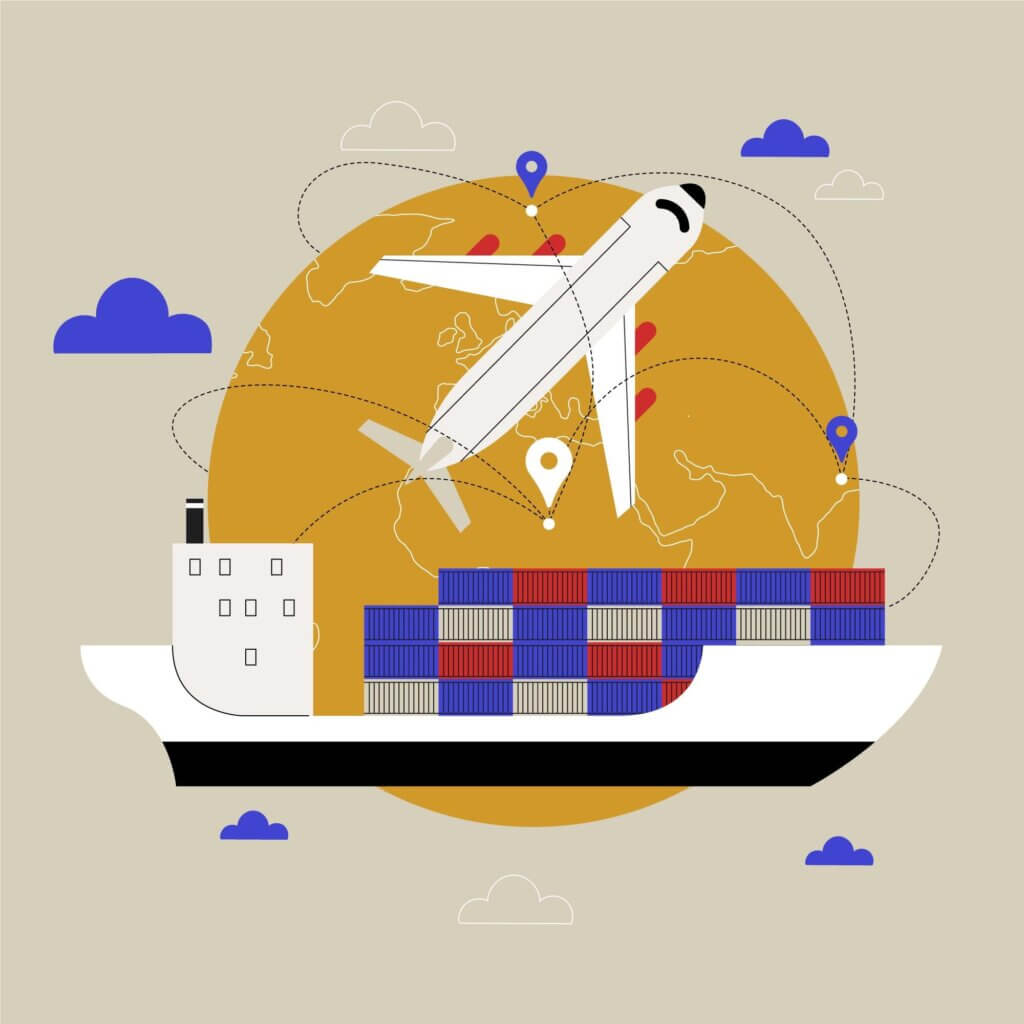
What is Intermodal Transport?
Intermodal transportation means the movement of goods using multiple modes of transportation, typically involving a combination of trucks, trains, ships, and airplanes.
It allows for the seamless transfer of cargo containers or trailers between different modes of transport, maximizing efficiency and reducing costs. Here are the key components and types of intermodal transportation:
Components of Intermodal Transportation
1. Modes of Transport:
Intermodal transportation utilizes various modes of transport, such as trucks, trains, ships, and airplanes. Each mode plays a specific role in the transportation chain, depending on the distance and type of cargo.
2. Infrastructure:
Intermodal transportation requires specialized infrastructure, including intermodal terminals, ports, rail yards, and airports. These facilities are equipped with handling equipment, such as cranes, forklifts, and container yards, to facilitate the transfer of goods between modes.
3. Containers and Trailers:
Standardized containers or trailers are used to package goods for intermodal transport. These containers are designed to be easily transferred between different modes of transportation and can be loaded and unloaded quickly and efficiently.
Types of Intermodal Transportation
1. Truck-Rail Intermodal:
This involves the movement of containers or trailers by both trucks and trains. The cargo is initially transported by truck to an intermodal terminal, where it is then loaded onto a train for the long-haul journey. At the destination, the cargo is transferred back to trucks for final delivery.
2. Rail-Ship Intermodal:
In this type, containers or trailers are transported by trains and ships. The cargo is first moved by train to a port, where it is loaded onto a ship for transportation across oceans or large bodies of water. Upon reaching the destination port, it is unloaded and may continue its journey by train or truck.
3. Truck-Air Intermodal:
This form of intermodal transport involves the use of trucks and airplanes. Goods are initially transported by truck to an airport, where they are loaded onto an aircraft for long-distance or international travel. Once the aircraft arrives at the destination airport, the cargo is transferred back to trucks for local distribution.
How Intermodal Transportation Works?
1. Origin and Packaging:
Goods are initially packaged and loaded into containers or trailers at the point of origin. This can be done at a manufacturer’s facility, warehouse, or distribution center.
2. Intermodal Terminal:
The loaded containers or trailers are transported by trucks to an intermodal terminal. Here, they are organized, inspected, and prepared for transfer to the next mode of transportation.
3. Transfer and Handling:
At the terminal, the cargo is transferred between different modes of transport. For example, containers may be lifted from trucks onto trains using cranes, or trailers may be loaded onto ships using specialized equipment.
4. Long-Haul Transport:
The cargo is transported over long distances using the chosen mode, such as trains, ships, or airplanes. This phase of the journey covers the bulk of the distance, often involving dedicated intermodal routes and networks.
5. Final Delivery:
Upon reaching the destination, the containers or trailers are transferred back to trucks for local delivery. The goods are unloaded from the containers or trailers and transported to their final destination, such as retail stores or distribution centers.
Intermodal transportation offers several advantages, including reduced transportation costs, increased efficiency, lower carbon emissions, and improved cargo security. It is a vital part of global supply chains, enabling the seamless movement of goods across various geographical regions.
Is Intermodal Transportation Growing?
Intermodal transportation is experiencing significant growth and expansion. According to CNBC, the intermodal transport of containers and trailers within North America alone exceeds 25 million times annually.
Furthermore, globally, there are currently over 20 million actively utilized intermodal containers. The widespread adoption of intermodal transportation is primarily due to its numerous advantages, which include enhancing efficiency, reducing costs, improving security, and accelerating delivery times.
These benefits have driven the promotion and development of intermodal transportation worldwide, resulting in the continuous expansion of trade routes and infrastructure across the globe.
Moreover, intermodal transport has undergone substantial advancements in line with technological progress. As online businesses increasingly rely on shipments, there is a constant demand for intermodal transport as these enterprises explore new markets.
Additionally, developing nations are witnessing a transition towards a more technologically advanced transportation industry. The digitalization of records and operations in this sector further supports intermodal transport, as digital records are easier to access and maintain, streamlining processes and improving overall efficiency.
Example:
A California-based electronics manufacturer intends to export its products to Europe and chooses intermodal transportation as its preferred method. The company securely packages the electronics in standardized containers at their manufacturing facility.
Trucks transport these containers to a nearby intermodal terminal, where they efficiently load them onto a train that embarks on a cross-country journey across the United States to a coastal port.
Upon reaching the port, the containers smoothly transition to a ship, which embarks on a voyage across the ocean to a European port.
Upon arrival, the containers unload and seamlessly transfer back onto trucks for the final leg of the journey, ensuring prompt delivery to various destinations throughout Europe.
This integration of trucks, trains, and ships within the intermodal transportation system enables the electronics manufacturer to achieve a streamlined and cost-effective process of shipping their goods from California to Europe.
Frequently Asked Questions:
- How does intermodal transportation contribute to cost reduction and efficiency?
Intermodal transportation optimizes the use of different modes of transport, leveraging their strengths for cost-effective and efficient cargo movement across various distances.
- Why is intermodal transport gaining popularity globally?
Intermodal transport offers improved security, faster delivery, and reduced costs, making it an attractive option for businesses seeking reliable and efficient logistics solutions in an increasingly interconnected world.
- What role does digitalization play in the growth of intermodal transport?
The digitalization of records and operations in the transportation industry enables easier access and management of information, enhancing the efficiency and effectiveness of intermodal transport systems and facilitating seamless coordination among multiple stakeholders.
